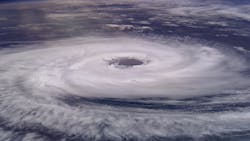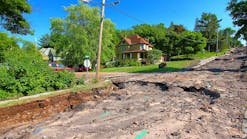New tool predicts flood risk from hurricanes in a warming climate
Researchers have developed a method to predict how much flooding a coastal community is likely to experience as hurricanes evolve over the next decades, according to a press release by the Massachusetts Institute of Technology (MIT).
Coastal cities and communities will face more frequent major hurricanes with climate change in the coming years. When multiple flood sources such as storm surge and rainfall interact, they can compound a hurricane’s hazards, leading to significantly more flooding than would result from any one source alone. The new study introduces a physics-based method for predicting how the risk of such complex, compound flooding may evolve under a warming climate in coastal cities.
One example of compound flooding’s impact is the aftermath from Hurricane Sandy in 2012. The storm made landfall on the East Coast of the United States as heavy winds whipped up a towering storm surge that combined with rainfall-driven flooding in some areas to cause historic and devastating floods across New York and New Jersey.
In their study, the team applied the new compound flood-modeling method to New York City to predict how climate change may influence the risk of compound flooding from Sandy-like hurricanes over the next decades.
They found that, in today’s climate, a Sandy-level compound flooding event will likely hit New York City every 150 years. By midcentury, a warmer climate will drive up the frequency of such flooding, to every 60 years. At the end of the century, destructive Sandy-like floods will deluge the city every 30 years — a fivefold increase compared to the present climate.
“Long-term average damages from weather hazards are usually dominated by the rare, intense events like Hurricane Sandy,” said study co-author Kerry Emanuel, professor emeritus of atmospheric science at MIT. “It is important to get these right.”
The researchers hope the flood forecasts can help city planners prepare and protect against future disasters.
“Our methodology equips coastal city authorities and policymakers with essential tools to conduct compound flooding risk assessments from hurricanes in coastal cities at a detailed, granular level, extending to each street or building, in both current and future decades,” said study author Ali Sarhadi, a postdoc in MIT’s Department of Earth, Atmospheric and Planetary Sciences.
The team’s open-access study appears online in the Bulletin of the American Meteorological Society.
Forecasting flood risk
To forecast a region’s flood risk, weather modelers typically look to the past. Historical records contain measurements of previous hurricanes’ wind speeds, rainfall, and spatial extent, which scientists use to predict where and how much flooding may occur with coming storms. But Sarhadi believes that the limitations and brevity of these historical records are insufficient for predicting future hurricanes’ risks.
“Even if we had lengthy historical records, they wouldn’t be a good guide for future risks because of climate change,” he said. “Climate change is changing the structural characteristics, frequency, intensity, and movement of hurricanes, and we cannot rely on the past.”
Sarhadi and colleagues instead looked to predict a region’s risk of hurricane flooding in a changing climate using a physics-based risk assessment methodology.
They first paired simulations of hurricane activity with coupled ocean and atmospheric models over time. With the hurricane simulations, developed originally by Emanuel, the researchers virtually scatter tens of thousands of “seeds” of hurricanes into a simulated climate. Most seeds dissipate, while a few grow into category-level storms, depending on the conditions of the ocean and atmosphere.
When the team drives these hurricane simulations with climate models of ocean and atmospheric conditions under certain global temperature projections, they can see how hurricanes change, for instance in terms of intensity, frequency, and size, under past, current, and future climate conditions.
The team then sought to precisely predict the level and degree of compound flooding from future hurricanes in coastal cities.
The researchers first used rainfall models to simulate rain intensity for a large number of simulated hurricanes, then applied numerical models to hydraulically translate that rainfall intensity into flooding on the ground during landfalling of hurricanes, given information about a region such as its surface and topography characteristics. They also simulated the same hurricanes’ storm surges, using hydrodynamic models to translate hurricanes’ maximum wind speed and sea level pressure into surge height in coastal areas.
The simulation further assessed the propagation of ocean waters into coastal areas, causing coastal flooding.
Then, the team developed a numerical hydrodynamic model to predict how two sources of hurricane-induced flooding, such as storm surge and rain-driven flooding, would simultaneously interact through time and space, as simulated hurricanes make landfall in coastal regions such as New York City, in both current and future climates.
“There’s a complex, nonlinear hydrodynamic interaction between saltwater surge-driven flooding and freshwater rainfall-driven flooding, that forms compound flooding that a lot of existing methods ignore,” Sarhadi said. “As a result, they underestimate the risk of compound flooding.”
With their flood-forecasting method in place, the team applied it to a specific test case: New York City. They used the multipronged method to predict the city’s risk of compound flooding from hurricanes, and more specifically from Sandy-like hurricanes, in present and future climates. Their simulations showed that the city’s odds of experiencing Sandy-like flooding will increase significantly over the next decades as the climate warms, from once every 150 years in the current climate, to every 60 years by 2050, and every 30 years by 2099.
Interestingly, they found that much of this increase in risk has less to do with how hurricanes themselves will change with warming climates, but with how sea levels will increase around the world.
“In future decades, we will experience sea level rise in coastal areas, and we also incorporated that effect into our models to see how much that would increase the risk of compound flooding,” Sarhadi said. “And in fact, we see sea level rise is playing a major role in amplifying the risk of compound flooding from hurricanes in New York City.”
The team’s methodology can be applied to any coastal city to assess the risk of compound flooding from hurricanes and extratropical storms.






